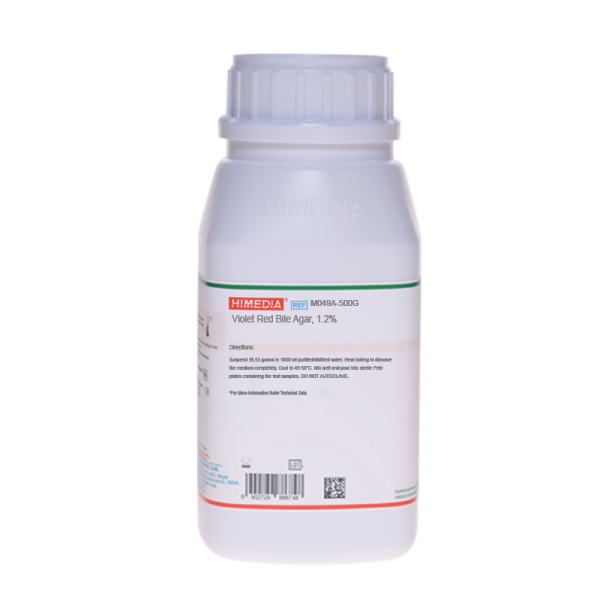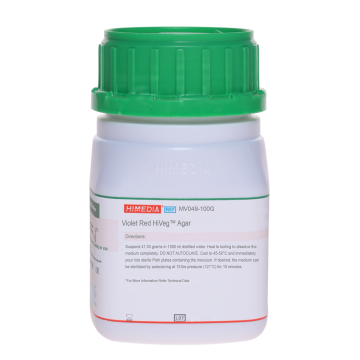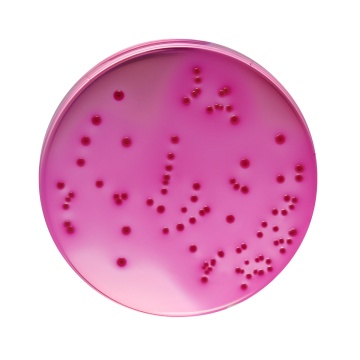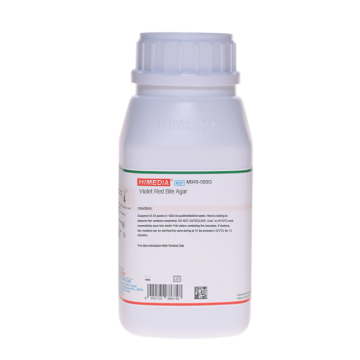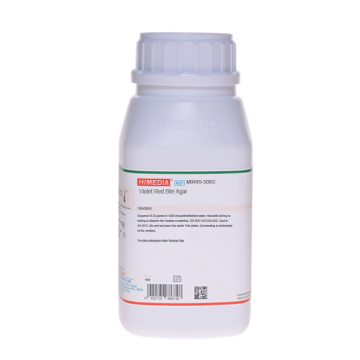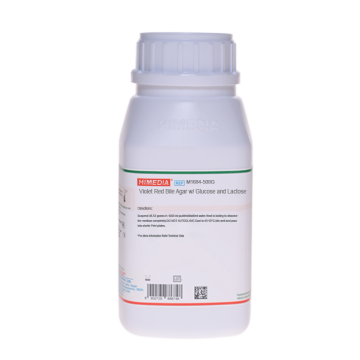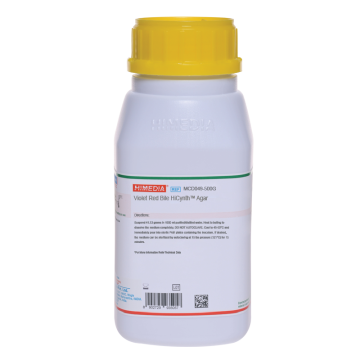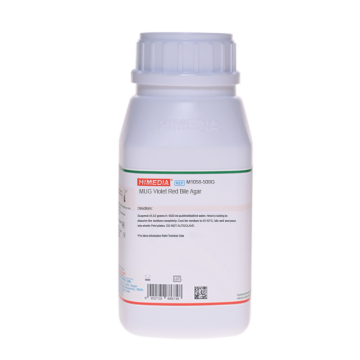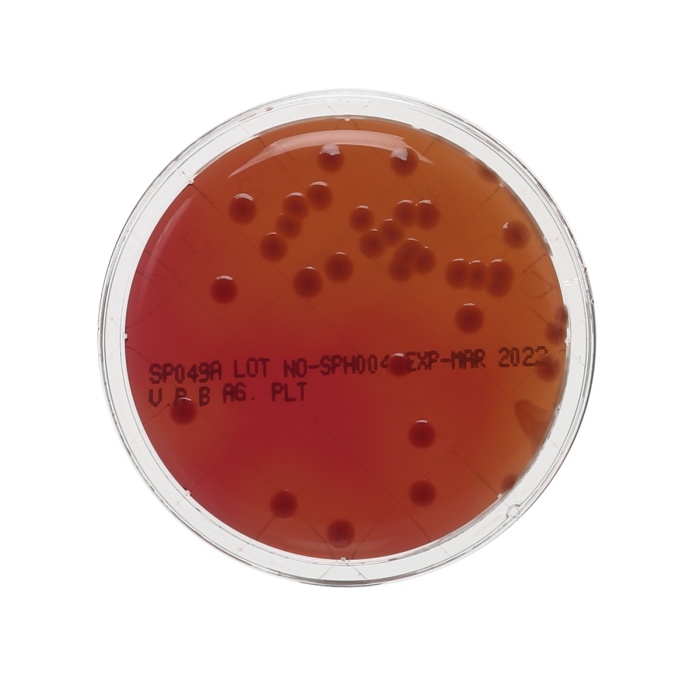 Your enquiry has been submitted
Your enquiry has been submitted
Violet Red Bile Agar (1.2%)
Intended Use:
Recommended for selective isolation and enumeration of coliaerogenes bacteria in water, milk and other dairy food products. It can also be used for clinical samples.
Composition**
| Ingredients | g / L |
|---|---|
| Peptone | 7.000 |
| Yeast extract | 3.000 |
| Lactose | 10.000 |
| Bile salts mixture | 1.500 |
| Sodium chloride | 5.000 |
| Neutral red | 0.030 |
| Crystal violet | 0.002 |
| Agar | 12.000 |
Final pH (at 25°C): 7.4±0.2
**Formula adjusted, standardized to suit performance parameters
Directions
Suspend 38.53 grams in 1000 ml purified / distilled water. Heat with stirring to boiling to dissolve the medium completely. DO NOT AUTOCLAVE. Cool to 45-50°C and pour into sterile Petri plates containing the test sample.
Principle And Interpretation
Violet Red Bile Agar, a modification of MacConkeys original formulation (1) is used for the enumeration of coli-aerogenes bacterial group. It relies on the use of the selective inhibitory components crystals violet and bile salts and the indicator system lactose, and neutral red. Thus, the growth of many unwanted organisms is suppressed, while tentative identification of sought bacteria can be made. Organisms, which rapidly attack lactose, produce purple colonies surrounded by purple halos. Non-fermenters or late lactose-fermenters produce pale colonies with greenish zones (2). VRBA is recommended by APHA (3,4).
Violet Red Bile Agar (1.2% Agar) (M049A) is prepared, in accordance with the ISO Committee (5,6).
Selectivity of VRBA can be increased by incubation under anaerobic conditions and/ or at elevated temperature, i.e. equal to or above 42°C (7,8,9).
Peptone and yeast extract serve as sources of carbon, nitrogen, vitamins and other essential growth nutrients. Lactose is the fermentable carbohydrate, utilization of which leads to the production of acids. Neutral red indicator detects the acidity so formed. Crystal violet and bile salts mixture help to inhibit the accompanying gram-positive and unrelated flora. Sodium chloride maintains the osmotic equilibrium. Violet Red Bile Agar is not completely specific for enterics; other accompanying bacteria may give the same reaction. Further biochemical tests are necessary for positive identification (10).
Type of specimen
Clinical samples - Stool; Food and dairy samples; Water samples
Specimen Collection and Handling:
For food and dairy samples, follow appropriate techniques for sample collection and processing as per guidelines (3,4,11).
For water samples, follow appropriate techniques for sample collection, processing as per guidelines and local standards (12,13).
For clinical samples follow appropriate techniques for handling specimens as per established guidelines (14,15). After use, contaminated materials must be sterilized by autoclaving before discarding.
Warning and Precautions :
In Vitro diagnostic Use. For professional use only. Read the label before opening the container. Wear protective gloves/protective clothing/eye protection/ face protection. Follow good microbiological lab practices while handling specimens and culture. Standard precautions as per established guidelines should be followed while handling clinical specimens. Safety guidelines may be referred in individual safety data sheets.
Limitations :
- Individual organisms differ in their growth requirement and may show variable growth patterns on the medium
- Each lot of the medium has been tested for the organisms specified on the COA. It is recommended to users to validate the medium for any specific microorganism other than mentioned in the COA based on the user's unique requirement.
- Further biochemical tests must be carried out for complete identification.
Performance and Evaluation
Performance of the medium is expected when used as per the direction on the label within the expiry period when stored at recommended temperature.
Quality Control
Appearance: Light yellow to pink homogeneous free flowing powder
Gelling: Firm, comparable with 1.2% Agar gel.
Colour and Clarity of prepared medium: Reddish purple coloured clear to slightly opalescent gel forms in Petri plates.
Reaction: Reaction of 3.85% w/v aqueous solution at 25°C. pH: 7.4±0.2
pH: 7.20-7.60
Cultural Response
Productivity: Cultural characteristics observed after an incubation at 30 ± 1°C for 24 ± 2 hours. Recovery rate is considered as 100% for bacteria growth on Reference Medium - Tryptone Soya Agar
Selectivity: Cultural characteristics observed after an incubation at 30 ± 1°C for 24 ± 2 hours.
Specificity: Cultural characteristics observed after an incubation at 30 ± 1°C for 24 ± 2 hours.
| Organism | Inoculum (CFU) | Growth | Recovery | Colour of colony |
|---|---|---|---|---|
| Escherichia coli ATCC 8739 (00012*) | 50-100 | luxuriant | >=50% | Purplish red colonies with or without precipitation halo |
| Escherichia coli ATCC 25922 (00013*) | 50-100 | luxuriant | >=50% | Purplish red colonies with or without precipitation halo |
| Enterococcus faecalis ATCC 29212 (00087*) | >=104 | inhibited | 0% | |
| Enterococcus faecalis ATCC 19433 (00009*) | >=104 | inhibited | 0% | |
| Pseudomonas aeruginosa ATCC 27853 (00025*) | 50-100 | luxuriant | >=50% | Colorless to beige colonies |
Key: (*) Corresponding WDCM numbers.
Storage and Shelf Life
Store between 10-30°C in a tightly closed container and the prepared medium at 20-30°C. Use before expiry date on the label. On opening, product should be properly stored dry, after tightly capping the bottle in order to prevent lump formation due to the hygroscopic nature of the product. Improper storage of the product may lead to lump formation. Store in dry ventilated area protected from extremes of temperature and sources of ignition. Seal the container tightly after use. Product performance is best if used within stated expiry period.
Disposal
User must ensure safe disposal by autoclaving and/or incineration of used or unusable preparations of this product. Follow established laboratory procedures in disposing of infectious materials and material that comes into contact with clinical sample must be decontaminated and disposed of in accordance with current laboratory techniques (14,15).
Reference
- MacConkey A., 1905, J. Hyg., 5, 333-379
- Corry J. E. L., Curtis G. D. W. and Baird R. M., (Ed.), 1995, Culture Media for Food Microbiology, Vol. 34, Progress in Industrial Microbiology, Elsevier, Amsterdam.
- Marshall R. T., (Ed.), 1992, Standard Methods for the Examination of Dairy Products, 16th Ed., APHA, Washington, D. C.
- Salfinger Y., and Tortorello M.L., 2015, Compendium of Methods for the Microbiological Examination of Foods, 5th Ed., American Public Health Association, Washington, D.C.
- Microbiology of food and animal feeding stuff - Horizontal method for the enumeration of coliforms- Colony count technique, International Organization for Standardization (ISO), 4832-2006.
- ISO 11133:2014(E), Microbiology of food, animal feed and water-Preparation, production, storage and performance testing of culture media.
- MacFaddin J. F., 1985, Media for Isolation-Cultivation-Identification-Maintenance of Medical Bacteria, Vol. 1, Williams and Wilkins, Baltimore.
- Mossel D. A. A. and Vega C. L., 1973, Hlth. Lab. Sci., 11:303
- Mossel D. A. A., Eclderink I., Koopmans M. and Van Rossem F., 1979, Food Protect., 42 : 470
- Mossel D. A. A. et al, 1986, J. Appl. Bacteriol., 60:289.
- American Public Health Association, Standard Methods for the Examination of Dairy Products, 1978, 14th Ed., Washington D.C.
- Baird R.B., Eaton A.D., and Rice E.W., (Eds.), 2015, Standard Methods for the Examination of Water and Wastewater, 23rd ed., APHA, Washington, D.C.
- Wehr H. M. and Frank J. H., 2004, Standard Methods for the Microbiological Examination of Dairy Products, 17th Ed., APHA Inc., Washington, D.C.
- Isenberg, H.D. Clinical Microbiology Procedures Handbook 2nd Edition.
- Jorgensen, J.H., Pfaller, M.A., Carroll, K.C., Funke, G., Landry, M.L., Richter, S.S and Warnock., D.W. (2015) Manual of Clinical Microbiology, 11th Edition. Vol. 1.
| Product Name | Violet Red Bile Agar (1.2%) |
|---|---|
| SKU | M049A |
| Product Type | Regular |
| Physical Form | Powder |
| Origin | Animal |
| Packaging type | HDPE |
| References | 1. Eaton A. D., Clesceri L. S. and Greenberg A. E., (Ed.), 1998, Standard Methods for the Examination of Water andWastewater, 20th Ed., American Public Health Association, Washington, D.C. 2.Downes F. P. and Ito K., (Ed.), 2001, Compendium of Methods for the Microbiological Examination of Foods, 4th Ed.,American Public Health Association, Washington, D.C. 3.MacConkey A., 1905, J. Hyg., 5, 333-379 4.Corry J. E. L., Curtis G. D. W. and Baird R. M., (Ed.), 1995, Culture Media for Food Microbiology, Vol. 34, Progress inIndustrial Microbiology, Elsevier, Amsterdam. 5.Marshall R. T., (Ed.), 1992, Standard Methods for the Examination of Dairy Products, 16th Ed., APHA, Washington, D. C. 5.International Organization for Standardization (ISO), 1991, Draft ISO/DIS 4382 6.Mossel D. A. A. and Vega C. L., 1973, Hlth. Lab. Sci., 11:303 |
| Customized Product Available | No |



